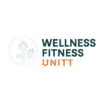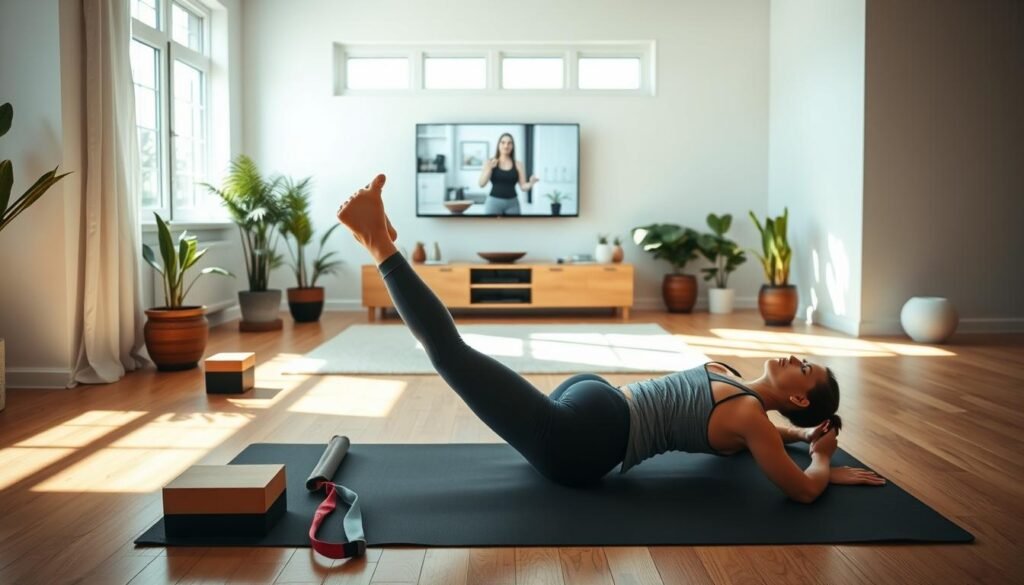You don’t need a gym or fancy gear to start working out. Simple bodyweight exercises can help you get stronger, more flexible, and full of energy. Home workouts save you time because you don’t have to travel. Plus, they’re cheaper and better for your health.
This guide has 30 easy exercises suggested by Hinge Health physical therapists. They’re perfect for beginners or those getting back into shape. You’ll learn how to do modified push-ups and chair-assisted squats safely.
Time is a big plus with home workouts. Just 20 minutes a day can make a big difference. You can even use things like water bottles or towels as weights. No need for special equipment.
Key Takeaways
- Home workouts require no equipment and fit into tight schedules
- Bodyweight exercises reduce injury risk while building foundational strength
- Short sessions (20+ minutes) can yield long-term health benefits
- Expert-approved routines ensure safe progression for all fitness levels
- Modifications allow customization based on mobility or energy levels
Understanding the Benefits of Exercise
Starting a fitness journey or looking to mix up your routine? Knowing why exercise is key can change how you see it. The American College of Sports Medicine (ACSM) suggests 150 minutes of moderate activity each week. Home workouts can help you reach this goal easily.
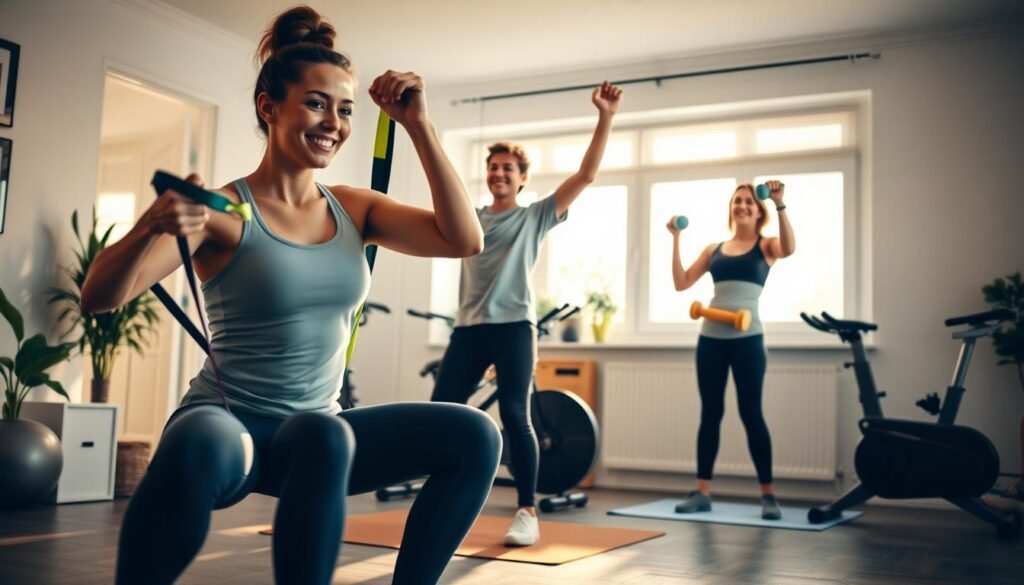
Why You Should Stay Active
Exercise does more than just burn calories. It also lowers injury risk by 23% by making joints and muscles stronger. Home workouts help you build strength and fight the dangers of sitting too much. Even simple moves like squats or push-ups help meet your weekly goal.
Physical and Mental Health Advantages
Your body wins big from regular exercise. Studies by Hinge Health show it cuts chronic pain by 40% by improving mobility. Exercise also boosts dopamine, the “feel-good” hormone, which helps with motivation and stress relief (Source 1).
Functional movements at home, like step-ups or planks, make daily tasks easier. Here’s how exercise affects different areas:
| Benefit Type | Physical Impact | Mental Impact |
|---|---|---|
| Short-Term | Increased energy levels | Immediate stress relief |
| Long-Term | Reduced chronic disease risk | Improved sleep quality |
| Daily Life | Stronger joints/muscles | Sharper focus |
Starting small is key. A 10-minute walk or simple stretches count toward your weekly goal. Remember, it’s progress over perfection when you’re new to fitness.
Essential Equipment for Home Workouts
Building a home gym doesn’t have to cost a lot. You can create a great workout space with smart choices. This space will support your entry-level fitness routines without taking up too much space. Let’s look at what you really need versus what’s just nice to have as you begin.
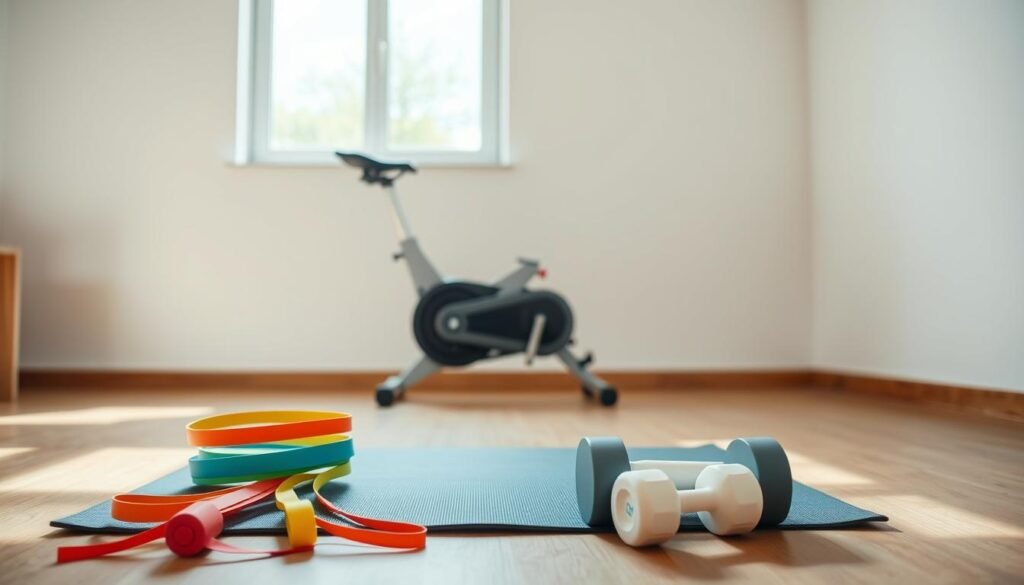
Must-Have Gear for Beginners
Start with these basics to cover 90% of your workout needs:
- Yoga mat: Provides cushioning for floor exercises and improves stability during planks or stretches.
- Resistance bands: Source 2 highlights these as versatile tools for strength training – perfect for squats, rows, and mobility work.
- Adjustable dumbbells: Source 3 recommends 5-25 lb sets for women and 10-40 lbs for men. These weights adapt as you progress.
- Reusable water bottle: Hydration impacts performance more than you might think.
“Even 5-minute movement snacks with minimal equipment can boost energy and focus throughout your day.”
Optional Equipment to Enhance Your Routine
Once you’ve mastered the basics, consider adding these tools:
| Equipment | Price Range | Best For |
|---|---|---|
| Stability Ball | $20-$50 | Core activation & balance training |
| Foam Roller | $15-$40 | Recovery & muscle tension relief |
| Kettlebell | $25-$80 | Dynamic full-body movements |
The Bureau of Labor Statistics reports Americans spent 12% more on home exercise gear in 2021 compared to previous years. But remember: More gear doesn’t equal better results. Focus on consistency first – you can always expand your toolkit later.
Bodyweight Exercises for Beginners
You don’t need fancy equipment to start building strength. Your own body is perfect for easy workouts. These foundational moves improve mobility, boost metabolism, and can be modified for any fitness level. Let’s break down three essential exercises that form the core of effective home training.
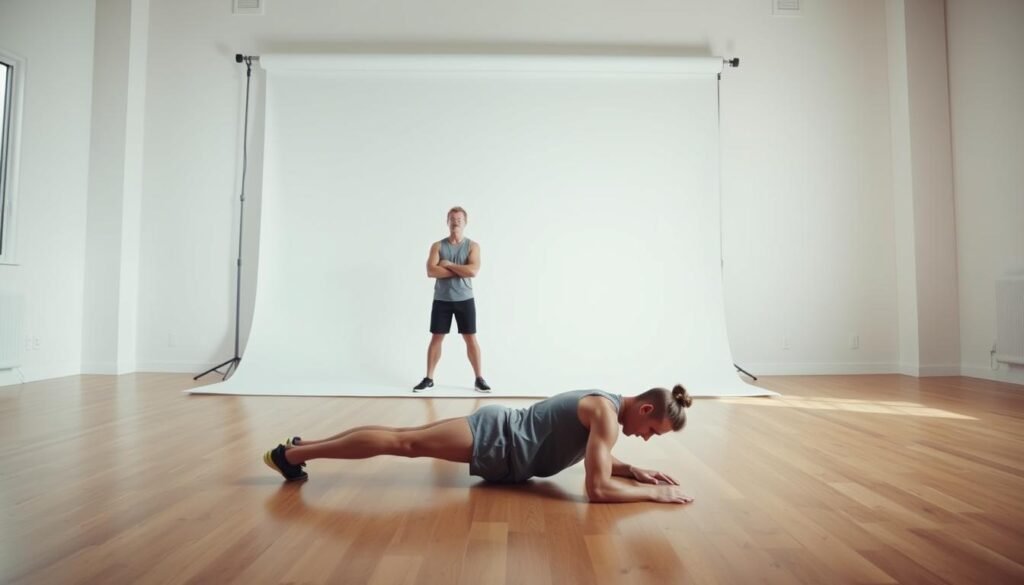
Squats: Basics and Variations
The bodyweight squat activates your entire lower body while improving balance. Start with chair-assisted squats: lower until your hips touch a seat, then push through your heels to stand. For progression, try box squats using a sturdy surface to control depth.
Pro tip: Keep your chest upright and knees aligned with toes. CNET recommends holding a water bottle at chest height to maintain proper form if you’re new to the movement.
Push-Ups: Techniques for All Levels
Wall push-ups offer the perfect starting point for upper body strength. Stand arm’s length from a wall, lean forward, and push back. As you gain confidence, progress to knee push-ups on the floor. Hinge Health suggests starting with 3-second descents to build control.
Common variations include:
- Incline push-ups (hands on elevated surface)
- Wide-grip push-ups for chest focus
- Narrow-grip push-ups for triceps engagement
Planks: Core Strength Made Easy
This isometric hold strengthens your entire midsection. Begin with 10-second knee planks, gradually working up to 30-second full planks. Focus on keeping your body in straight line from head to heels.
| Exercise | Target Muscles | Beginner Variation | Rep Range |
|---|---|---|---|
| Squats | Quads, Glutes | Chair-Assisted | 2×10-15 |
| Push-Ups | Chest, Shoulders | Wall Push-Ups | 2×8-12 |
| Planks | Core, Back | Knee Planks | 2×15-30 sec |
Combine these moves into a 15-20 minute circuit: perform each exercise for 10-15 reps (or 30 seconds for planks), rest 60 seconds, then repeat. This simple routine builds functional strength without overwhelming newcomers to easy workouts for beginners.
Low-Impact Cardio Options
Low-impact cardio is gentle on your body but still effective for fitness. It’s perfect for all fitness levels, especially beginners or those with injuries. These workouts help you burn calories, improve your mood, and increase stamina without putting too much strain on your joints.
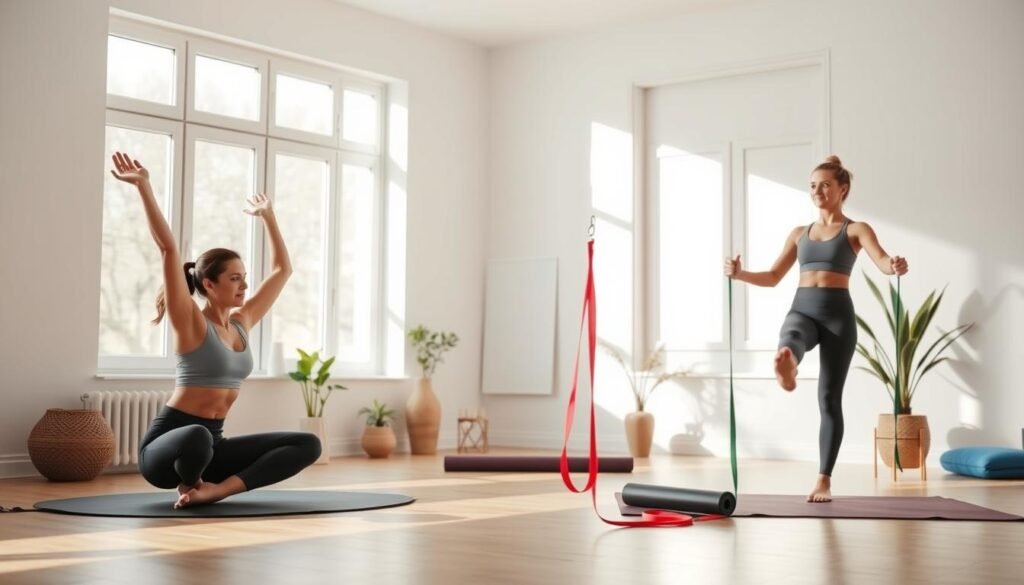
Walking: Your Starter Cardio Workout
Walking is easy and can fit into any schedule. A 30-minute brisk walk can burn 149 calories for a 155-pound person. It also strengthens your leg muscles. Try adding stair climbing or interval walks for extra challenge.
Hinge Health suggests taking three 5-minute walks a day instead of one long walk. Park further away or take the stairs to get more steps in.
Dancing: Fun and Effective
Make your living room a dance floor! Dancing at a moderate pace can burn 167 calories in 30 minutes. It also improves your coordination. Use free YouTube tutorials or apps like Nike Training Club for dance routines.
Try line dancing, Zumba, or freestyle dancing. The goal is to dance for at least 20 minutes. Plus, dancing to your favorite songs makes it feel like you’re not even working out.
Swimming: A Full-Body Workout Alternative
Swimming works out every major muscle group and is joint-friendly. It burns 223 calories in 30 minutes, great for those with arthritis or recovering from injuries. Many pools offer shallow-water aerobics classes for added variety.
Focus on proper form to get the most out of swimming. Try alternating laps with water jogging or using foam noodles for resistance. Even gentle movements in the pool can help build strength and flexibility over time.
| Activity | Duration | Calories Burned* | Intensity Level |
|---|---|---|---|
| Brisk Walking | 30 minutes | 149 | Moderate |
| Dancing | 30 minutes | 167 | Moderate |
| Swimming | 30 minutes | 223 | Light |
*Based on a 155-pound adult. Calorie burn increases with weight and intensity.
Strength Training Basics
Strength training is key for a well-rounded workout, even if you’re just starting out. You can use dumbbells, resistance bands, or your own body weight. These basic exercises for beginners help build muscle and increase your metabolism safely.
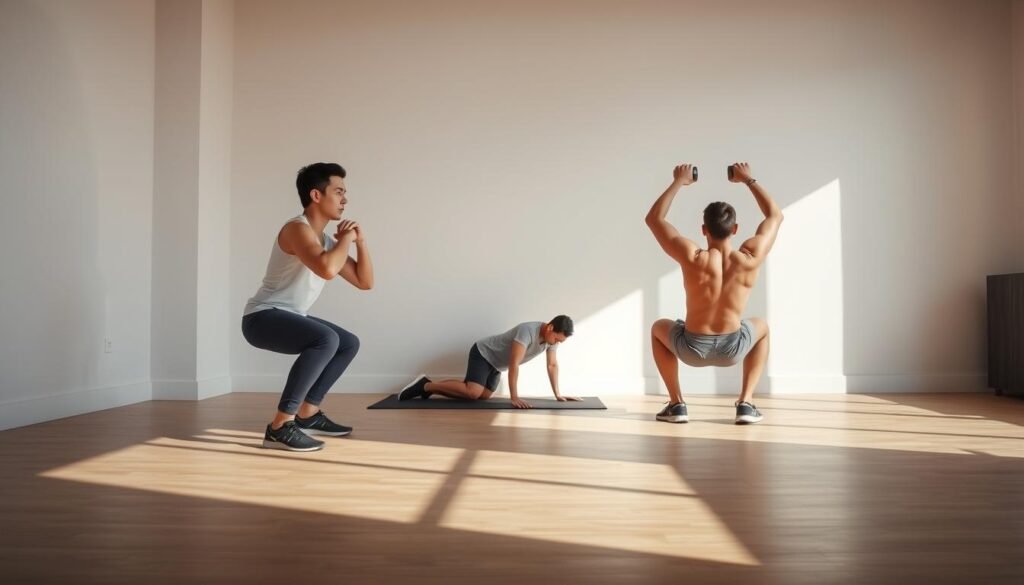
Introduction to Resistance Training
Resistance training means working against a force to get stronger. Start with lighter weights and focus on getting your form right. Dr. Sarah Guyett suggests adding 5-10% more weight each week once you feel comfortable. This slow increase helps avoid injuries and builds strength.
Simple Dumbbell Exercises
Dumbbells are great for working out at home. Here are some easy exercises to try:
- Bent-Over Rows: Bend at the hips, keep your back straight, and pull the weights towards your chest. This works your upper back.
- Tricep Dips: Sit on a sturdy chair with your hands gripping it, lower your body slowly, and then push back up. Hinge Health’s guide reminds you to keep your shoulders relaxed.
Do 2 sets of 10-12 reps for each exercise. Focus on slow and controlled movements.
Using Resistance Bands Safely
Bands are a good option for adding challenge without heavy weights. But, using them wrong can hurt your joints. Here are some mistakes to avoid from Source 1:
- Stretching bands too far beyond their limit
- Letting the bands snap back without control
- Using bands that are torn or worn out
Try the banded fire hydrant (Source 2): Loop a band around your knees, lift one leg sideways while kneeling, and repeat. This exercise strengthens your glutes without putting strain on your lower back.
Stretching and Flexibility Exercises
Flexibility is not just for gymnasts or yoga pros. It’s a game-changer for anyone. Adding stretches to your routine keeps muscles limber. It reduces injury risks and helps you move easily during daily activities. Let’s explore how to make stretching work for you.
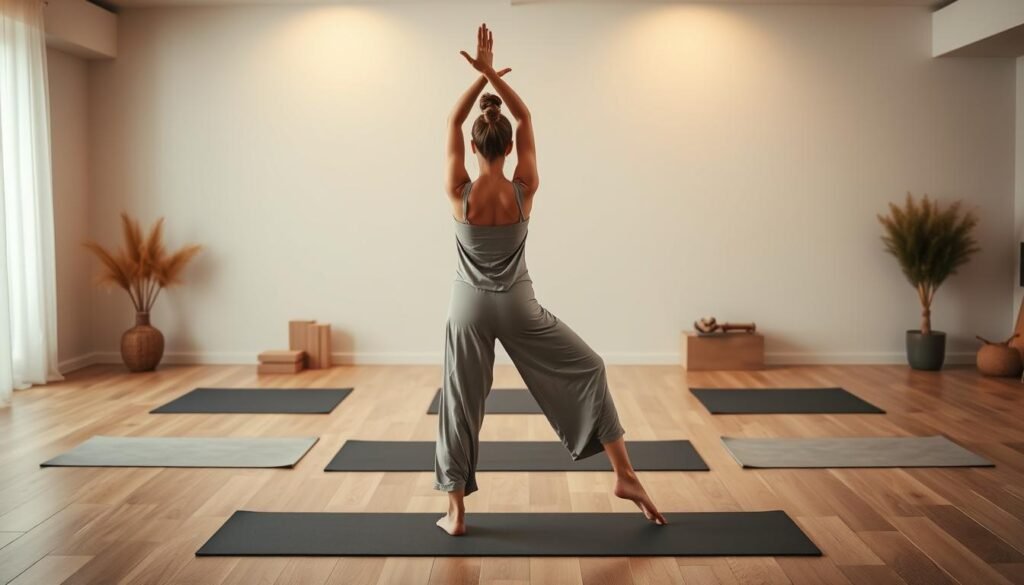
Why Stretching Matters
Stretching does more than loosen tight muscles. It boosts blood flow and improves posture. It even calms your mind. Think of it as hitting the “reset” button after sitting all day or crushing a workout.
For desk workers, Hinge Health recommends a seated hamstring stretch. Sit tall, extend one leg, and reach toward your toes for 20 seconds.
Simple Stretches for Every Body Part
Try these moves to target major muscle groups:
- Plank to Downward Dog: Start in a plank position, then push your hips up and back into an upside-down V shape. Hold for 10 seconds to stretch shoulders and hamstrings.
- Superman Stretch: Lie face down, lift arms and legs off the ground, and hold for 5 seconds to strengthen your back while stretching your core.
- Neck Rolls: Slowly tilt your head side to side to release tension from desk work—perfect for following Source 3’s mobility tips.
| Stretch | Target Area | Duration |
|---|---|---|
| Seated Hamstring | Legs/Lower Back | 20-30 seconds |
| Downward Dog | Shoulders/Hamstrings | 10-15 seconds |
| Superman | Core/Back | 5-8 seconds |
3 Flexibility Hacks You’ll Love
Want to bend further without strain? Try these tips:
- Warm up first—a quick walk or light jog preps muscles for deeper stretches.
- Breathe deeply during each stretch to oxygenate tissues and enhance relaxation.
- Consistency beats intensity: 5 minutes daily works better than one hour weekly.
Creating a Balanced Workout Routine
Creating a workout plan that fits your lifestyle is easy. It’s all about balancing different exercises and listening to your body. Let’s explore how to make a routine that grows with you.
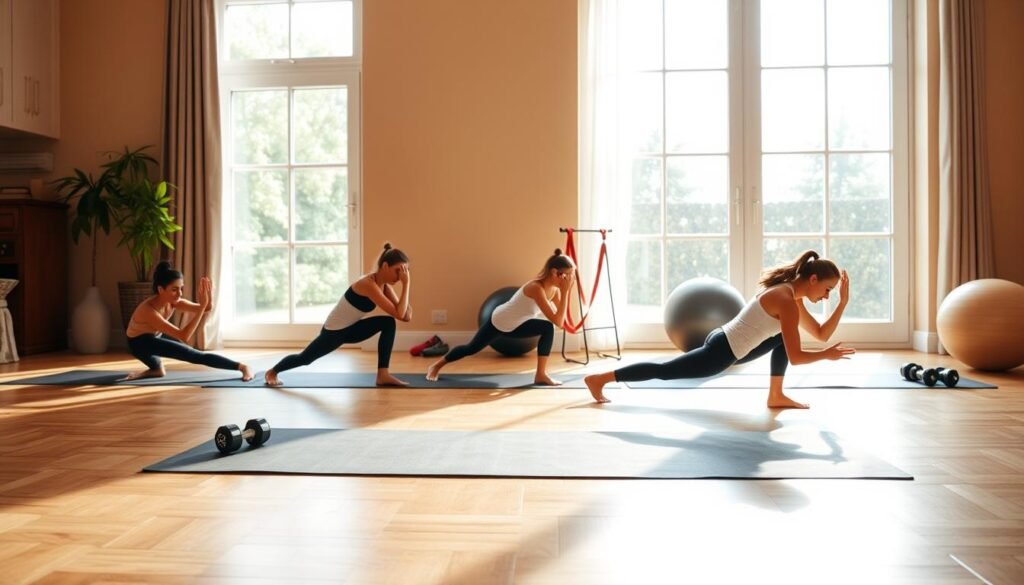
How to Structure Your Weekly Plan
Begin with 2-3 full-body workouts a week if you’re new. Fitness experts suggest this. Mix strength training and cardio days to avoid burnout. Here’s an example:
| Schedule Type | Days | Focus Areas | Rest Intervals |
|---|---|---|---|
| 3-Day Full Body | Mon/Wed/Fri | Strength + 15min cardio | 1min between sets |
| 5-Day Split | Mon-Fri | Targeted muscle groups + cardio | 45-60sec rest |
Use the 5-minute rule from Hinge Health. Start with just five minutes if you’re not feeling it. Often, you’ll end up doing more.
Mixing Different Types of Exercises
Combine bodyweight exercises, resistance training, and low-impact cardio for a balanced workout. Try this mix:
- 2 days strength training (dumbbells or bands)
- 2 days cardio (dancing or brisk walking)
- 1-2 days flexibility work (stretching/yoga)
Change exercises every 4-6 weeks to keep things interesting. This prevents boredom and keeps your workouts effective.
Setting Realistic Goals and Expectations
Focus on progress, not perfection. Aim for small victories like:
- Adding 2 reps to your push-ups weekly
- Holding planks 5 seconds longer each session
- Reducing rest intervals by 15 seconds monthly
CNET suggests journaling your workout wins. Did you try a new squat variation or master a dance? Celebrate these small achievements for lasting motivation.
Staying Motivated While Exercising at Home
Keeping up with your fitness at home is more than just wanting to. It takes smart plans. Home workouts lack the accountability of gyms. So, we need to find ways to stay on track and make exercise enjoyable.

Tips for Maintaining a Workout Schedule
Habit stacking is a game-changer: link exercise to daily habits like morning coffee or evening cleaning. Studies show that breaking workouts into 5-minute “snacks” boosts sticking to it by 38%.
Here are some easy changes:
- Keep your workout clothes in sight
- Use visual trackers to mark your progress
- Set workout times as non-negotiable in your calendar
Using Technology to Keep You Engaged
Free apps turn your living room into a gym. Nike Training Club has over 200 easy routines that don’t need any equipment. Seven offers 7-minute workouts for those with tight schedules. FitOn has strength training sessions led by celebrities.
Use rewards wisely: only listen to your favorite podcast or audiobook during workouts. This way, you’ll look forward to exercising to hear more. Apps like Habitica turn fitness goals into games, letting you “level up” as you achieve them.
“Micro-commitments are the secret sauce. People who focus on showing up for just five minutes daily build routines 4x faster than those aiming for 30-minute sessions from day one.”
Common Mistakes to Avoid as a Beginner
Starting a fitness journey is exciting, but small errors can slow you down. Many beginner workout mistakes come from being too eager. Knowing these mistakes early helps build lasting habits and lowers injury risks.
Overexerting Yourself: Know Your Limits
Trying too hard too fast can lead to burnout or injury. Hinge Health suggests starting slow, especially with strength training. If your muscles shake or you feel pain, cut back on weight or reps.
Use apps like Fitbod to track your workouts. This helps avoid doing too much too soon, as fitness coaches warn.
Skipping Warm-Ups and Cool-Downs
Dynamic stretches like leg swings or arm circles get your joints ready. ISSA suggests 5–10 minutes of light cardio before lifting. After, use static stretches for hamstrings and shoulders to boost flexibility.
This routine helps prevent back pain and speeds up recovery, studies by the American Council on Exercise show.
Neglecting Rest and Recovery
Muscles grow when you’re not working them. CNET says to wait 48 hours between training the same muscles. Foam rolling or yoga on rest days keeps you flexible without overdoing it.
Even top athletes like LeBron James know the importance of sleep and staying hydrated. Listen to your body—when you’re tired, it’s time to rest.
FAQ
Why should I prioritize home workouts as a beginner?
Home workouts save time and money. They offer scalable bodyweight exercises. Hinge Health physical therapists recommend 30 foundational movements like bridges and modified pushups that build strength without equipment. Studies show consistent home exercise reduces chronic pain by 40% and triggers dopamine release for mental health benefits.
What basic equipment do I need to start exercising at home?
Start with a yoga mat and water bottles as weights. Hinge Health’s “movement snacks” concept proves effective workouts require minimal gear. For strength training, Source 3 recommends 5-25lb dumbbells for women and 10-40lbs for men. BLS data shows 68% of exercisers spent under 0 on equipment in 2021.
How long should beginner workouts last?
ACSM guidelines suggest 150 weekly minutes of activity. Start with 15-20 minute sessions using CNET’s box squat modification or wall pushups. Hinge Health recommends two sets of 10-15 reps for foundational moves like stationary lunges, paired with 1-minute rest intervals between exercises.
Can low-impact exercises provide real health benefits?
Absolutely. Pool workouts from Source 2 reduce joint stress for arthritis sufferers while improving mobility. Living room dance sessions burn 150-200 calories/hour, and Hinge Health’s research shows brief “exercise snacks” throughout day improve metabolic health as effectively as longer sessions.
How do I safely progress in strength training?
Follow physical therapist Guyett’s 5-10% weight increase rule. Master form first using Hinge Health’s tricep dip tutorial and Source 3’s dumbbell row demonstrations. Avoid Source 1’s documented resistance band mistakes by maintaining tension control and proper joint alignment.
What recovery practices prevent beginner injuries?
Post-workout stretching is crucial. Try Source 1’s plank to Downward Dog transition and Hinge Health’s seated hamstring stretch. CNET recommends 48-hour recovery periods between strength sessions. Source 3’s desk worker mobility drills combat stiffness when paired with proper hydration.
How can I stay motivated without a gym environment?
Use Hinge Health’s “5-minute rule” to build consistency – just start short sessions. Source 2’s habit stacking technique pairs workouts with existing routines. Track progress through CNET’s journaling method or Nike Training Club’s free app programs. Source 3’s podcast reward system helps maintain engagement.
What are the most common beginner mistakes to avoid?
Source 3 warns against “too much too soon” syndrome. Always complete Source 1’s dynamic warmup protocols first. Hinge Health data shows 62% of injuries stem from skipping cooldowns. Avoid Source 1’s form errors in pushups by maintaining straight spine alignment throughout movements.
